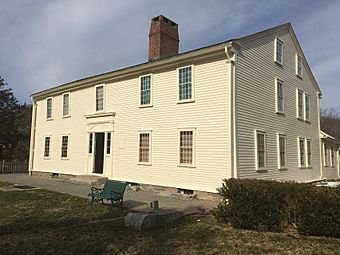Smith's Castle facts for kids
|
Cocumscussoc Archeological Site
|
|

Front elevation of Smith's Castle house, 2018
|
|
| Location | Wickford, RI |
|---|---|
| Nearest city | Warwick |
| Area | 10 acres (4.0 ha) (1972 NRHP nomination) 1.8 acres (0.73 ha) (1993 NHL nomination) |
| Built | 1678 (house) |
| Architectural style | Colonial |
| NRHP reference No. | 72000010 (original) 93000605 (increase) |
Quick facts for kids Significant dates |
|
| Added to NRHP | February 23, 1972 |
| Boundary increase | April 12, 1993 |
| Designated NHL | April 12, 1993 |
Smith's Castle is a very old house in North Kingstown, Rhode Island. It was built in 1678 and is now a museum. You can find it near Wickford village. This historic home is one of the oldest houses in Rhode Island.
In 1993, it became a National Historic Landmark. It was recognized as the Cocumscussoc Archeological Site. This is because many old objects and important information have been found there through archeological digs. The site is located right off U.S. Route 1 in Rhode Island.
Contents
The Story of Smith's Castle
Early Beginnings and Roger Williams
The first building on this land was destroyed during a conflict called King Philip's War. The current house was built in 1678 to replace it. The area where the house stands was known as Cocumscussoc. It was close to the first trading post of Roger Williams.
Roger Williams was a very important person in Rhode Island's history. He founded Providence Plantations and was a leader in the Baptist church. He built his trading post here in 1637. He traded with the Narragansett Tribe, who had given him the land. Later, Williams sold the trading post to a man named Smith. He used the money to travel to Great Britain. His goal was to get a special paper called a charter for Rhode Island.
Building the "Castle"
The first Smith, Richard Smith, built a large, strong house. It was so strong that people started calling it a "castle." His son, Richard Smith Jr., took over the property in 1666. During King Philip's War, he allowed soldiers from Massachusetts and Connecticut to use the property.
Sadly, the house was burned down as a result of the Great Swamp Fight. The house you see today was built in its place. It started as a "saltbox" style house. Over time, it was changed into its current look.
Important Events and Burials
About 40 soldiers were buried on the property during King Philip's War. These soldiers died in December 1675. They were either killed in the Great Swamp Fight or on their way back from it.
In 1676, a very severe event happened at Smith's Castle. An English colonist named Joshua Tefft was found guilty. He had fought alongside the Narragansetts during the Great Swamp Fight. He was executed here in a very harsh manner.
Later Owners and Museum Life
Over the years, the property was owned by the Updike, Congdon, and Fox families. Some famous people lived there, like Lodowick and Abigail Updike. Their daughter, Sarah Updike Goddard, and her children, Mary Katherine Goddard and William Goddard, were all well-known printers. They printed important papers during the colonial era.
Smith's Castle was a large dairy farm for many years. In the early 1900s, it became a museum. People like Norman Isham and John Hutchins Cady helped to fix up the house. They made sure it would last for many more years.
More to Explore
- List of the oldest buildings in Rhode Island
- List of National Historic Landmarks in Rhode Island
- National Register of Historic Places listings in Washington County, Rhode Island
Images for kids
-
Mass grave of forty unnamed men who died in the Great Swamp Fight or on the return march in December 1675






